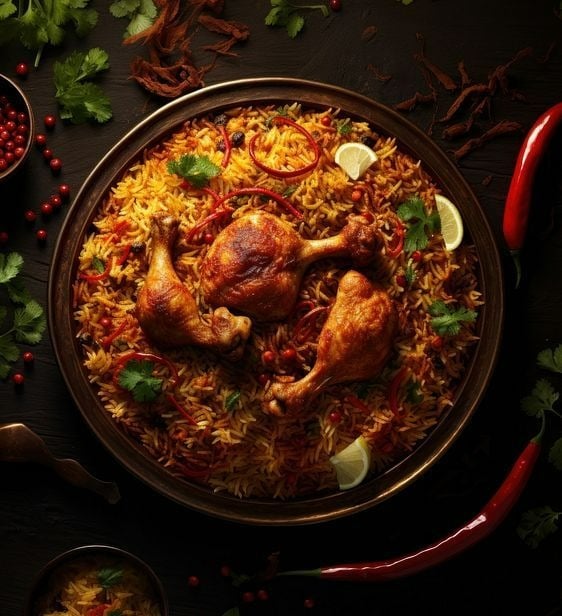The History of Biryani: A Culinary Journey Through Time
Explore the rich history and evolution of Biryani, a beloved dish that has traveled through time and cultures, offering a flavorful journey from its origins to its global popularity.
FOOD CHRONICLES
deepita
1/19/20253 min read


Biryani, the quintessential dish of Indian cuisine, is a symphony of flavors, aromas, and textures that tantalizes taste buds like no other. But how did this magnificent dish find its way to India? Who introduced it, and why do we have such a delightful diversity in biryani recipes across the country? Let’s embark on a flavorful journey through the history of biryani, uncovering its origins, evolution, and regional variations.
The Origins of Biryani
The word “biryani” is derived from the Persian word birian, meaning “fried before cooking,” and birinj, meaning “rice.” It is widely believed that biryani originated in Persia (modern-day Iran) and made its way to the Indian subcontinent through the Mughals. The Mughal emperors, known for their love of art, architecture, and cuisine, brought this dish with them during their conquest of India in the 16th century.
Introduction to India by the Mughals
Emperor Babur and his successors introduced Persian culinary traditions to India, which blended seamlessly with local flavors. Biryani, in its earliest form, was a hearty, aromatic dish meant to satisfy the hunger of soldiers. Legend has it that biryani was cooked in massive pots, layered with meat, rice, and spices, and sealed with dough to retain its flavors. This method, called dum, is still used today and remains integral to biryani preparation.
One famous anecdote credits Mumtaz Mahal, the queen behind the Taj Mahal, for popularizing biryani. She reportedly ordered her chefs to prepare a wholesome, nutritious dish for the Mughal army, leading to the creation of biryani as we know it.
Regional Variations: Why Every State Has Its Own Recipe
India’s diverse geography and cultural influences have given birth to numerous biryani styles, each reflecting the region’s unique tastes and traditions. As the Mughals expanded their empire, biryani adapted to local ingredients, spices, and cooking techniques, resulting in distinct regional versions:
Hyderabadi Biryani
Arguably the most famous, this biryani evolved under the Nizams of Hyderabad. It comes in two main types: Kacchi (raw meat and rice cooked together) and Pakki (cooked meat layered with rice). The use of saffron, dried fruits, and yogurt gives it a royal touch.
Lucknowi (Awadhi) Biryani
Originating from the kitchens of the Nawabs of Awadh, this biryani is known for its mild flavors and aromatic dum pukht cooking style. It uses marinated meat, fragrant spices, and long-grain rice.
Kolkata Biryani
A legacy of Nawab Wajid Ali Shah, this biryani features potatoes, a unique addition due to the Nawab’s budget constraints during his exile. The dish is lightly spiced and often includes boiled eggs.
Malabar Biryani
A coastal delight from Kerala, this biryani uses short-grain rice and is infused with coconut and curry leaves, reflecting the region’s local ingredients.
Dindigul Biryani
Hailing from Tamil Nadu, this biryani is tangy and spicy, made with seeraga samba rice, small-grain rice that absorbs flavors beautifully.
Bangalore Donne Biryani
Served in donnes (areca leaf bowls), this biryani is packed with earthy flavors and has a slightly smoky aroma.
Bhatkali Biryani
From Karnataka’s coastal regions, this biryani is known for its fiery red color, thanks to an abundance of chili and tomato-based masala.
Interesting Facts About Biryani
Not Just Meat: While traditionally made with meat, biryani has evolved to include vegetarian versions like paneer biryani and jackfruit biryani, catering to India’s diverse dietary preferences.
Royal Influence: Biryani often features expensive ingredients like saffron, rose water, and ghee, reflecting its royal origins.
Global Appeal: Biryani isn’t just an Indian favorite. Variations like Pakistani biryani, Sri Lankan biryani, and Arabian mandi show its global influence.
A Dish of Unity: Despite its regional differences, biryani unites India like no other dish, transcending cultural and religious boundaries.
The Legacy of Biryani
Today, biryani is much more than just food—it’s an emotion, a celebration, and a symbol of India’s rich culinary heritage. From the streets of Old Delhi to the kitchens of luxury hotels, biryani continues to evolve while staying true to its essence: a harmonious blend of rice, spices, and love.
Whether you’re savoring a plate of Hyderabadi biryani or relishing the unique flavors of Kolkata’s version, every bite tells a story of history, tradition, and the people who made this dish a timeless favorite. So the next time you dig into a plate of biryani, remember—you’re tasting centuries of culture in every mouthful.
